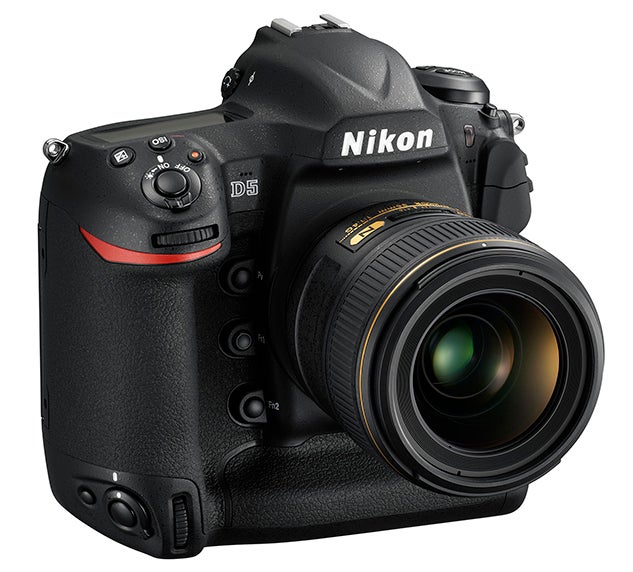The new Canon EOS 1D-X Mark II arrives a month after the Nikon D5, the camera that’s easily its closest rival for the professional user, but how do the two compare? Here are 13 key differences between the two models.

Canon EOS 1D-X Mark II vs Nikon D5 – Sensor
Both cameras employ full-frame sensors for image and video capture, but while the EOS 1D-X Mark II’s offers 20.2MP (effective), the D5 boasts a marginally greater 20.8MP (effective). Whether this makes any significant difference, however, is yet to be seen.
Canon EOS 1D-X Mark II vs Nikon D5 – ISO Range
Arguably the most shocking aspect of the D5’s announcement was the news that it could shoot at a Hi 5 setting equivalent to ISO 3,280,000 – far higher than anything we’ve seen before. The camera’s standard ISO range runs between ISO 100-102,400, and there’s also an extension setting equivalent to ISO 50 at the other end of the scale. By contrast, the EOS 1D-X Mark II can shoot between ISO 100-51,200 as standard, with an extension setting equivalent to ISO 50 at the low end and ISO 409,600 at the upper end.
Canon EOS 1D-X Mark II vs Nikon D5 – Video
Both cameras are capable of 4K and Full HD video recording, although there are differences. While the D5 records 4K footage in the UHD resolution of 3840 x 2160 pixels, at 30/25/24p frame rates, the EOS 1D-X Mark II records this in the slightly higher DCI 4K resolution of 4096 x 2160 pixels up to a maximum 60p. With a suitably fast memory card, the D5 can record this footage for up to 3 minutes at a time, while the EOS 1D-X Mark II can manage a second under 30 mins without needing a breather. It’s also possible to extract an 8.8MP JPEG from 4K footage with the EOS 1D-X Mark II, and the camera employs the previously seen Dual Pixel CMOS AF and Movie Servo AF technology to handle autofocus during video recording. One advantage of the D5, however, is that it can be used to produce 4K time-lapse footage in camera.
Canon EOS 1D-X Mark II vs Nikon D5 – LCD screen
Both cameras sport 3.2in LCD screens on their back, although there are differences. The EOS 1D-X Mark II’s screen resolves details with 1.62million dots and is sensitive to touch, which allows the focus point to be selected through the screen in either live view or movie modes. The D5’s screen has a considerably higher 2.36million dots and is also touch sensitive, with touch functionality available in both shooting and playback modes.
Canon EOS 1D-X Mark II vs Nikon D5 – Viewfinder magnification
Each camera has a pentaprism viewfinder that offers approximately 100% coverage of the scene, although the magnification of the EOS 1D-X Mark II is a slightly higher 0.76x, next to the D5’s 0.72x.
Canon EOS 1D-X Mark II vs Nikon D5 – Burst rate
The D5 can be programmed to fire at 12fps, or alternatively 14fps with the mirror up throughout the burst. The EOS 1D-X Mark II does slightly better, with approximately 14fps offered as standard (with AF and AE) and a maximum of 16fps with the mirror locked up in live view, with AF and exposure fixed to that of the first frame. This is attributed to the use of two DIGC 6+ processing engines.
Canon EOS 1D-X Mark II vs Nikon D5 – Burst depth
With a CFast card, the EOS 1D-X Mark II can shoot at 14fps for up to 170 Raw frames or unlimited JPEGs, with AF and metering maintained throughout. The D5, meanwhile, can capture up to 200 losslessly compressed Raw frames at its 12fps burst setting, when using an XQD card.
Canon EOS 1D-X Mark II vs Nikon D5 – AF systems
The two vary considerably when it comes to their respective AF systems. The D5 sports a new Multi-CAM 20K AF module that’s also been included in the D500. This offers 153 AF points in total, with 99 cross-type points and 53 that can be manually selected (the rest are assist points). Nikon claims this is sensitive between -4EV to +20EV, which should allow it to pick out subjects in even very dark conditions. By contrast, the EOS 1D-X Mark II has a 61-point AF system, with 41 cross-type points (including 5 dual cross-type points) and sensitivity between -3EV and 18EV.
Canon EOS 1D-X Mark II vs Nikon D5 – Metering sensor
Both cameras feature new metering sensors, each said to be more accurate than previous versions. While the EOS 1D-X Mark II is equipped with a new 360,000-pixel sensor, the D5 offers a 180,000-pixel alternative.
Canon EOS 1D-X Mark II vs Nikon D5 – GPS
The Nikon D5 doesn’t have a GPS system on board, although this is included in the EOS 1D-X Mark II as standard. This provides latitude, longitude and elevation, and thanks to the built-in compass, direction.
Canon EOS 1D-X Mark II vs Nikon D5 – Battery life
The Nikon D5 races ahead with its claimed battery life. Nikon reckons the provided EN-EL18a battery can last up to 3780 shots on a single charge, next to the EOS 1D-X Mark II’s maximum 1210 shots achievable by its LP-E19 battery.
Canon EOS 1D-X Mark II vs Nikon D5 – Memory cards
The D5 is available in two flavours, one with twin XQD slots and the other with two CompactFlash slots. The EOS 1D-X Mark II, meanwhile, comes in one option that sees a CompactFlash port that’s compatible with UDMA 7 cards partnered with a CFast 2.0 slot.
Canon EOS 1D-X Mark II vs Nikon D5 – Weight
There’s not much between the two models when it comes to weight, with the Nikon D5 weighing 1,405g with its battery and two XQD memory cards, and 1,415g with two CompactFlash memory cards, and the EOS 1D-X Mark II weighing 1,530g with its battery in place.





